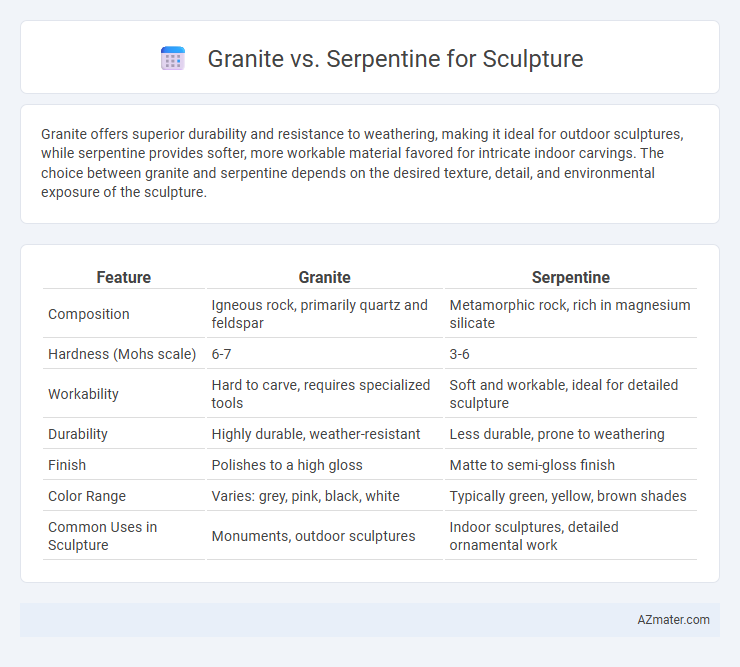Granite offers superior durability and resistance to weathering, making it ideal for outdoor sculptures, while serpentine provides softer, more workable material favored for intricate indoor carvings. The choice between granite and serpentine depends on the desired texture, detail, and environmental exposure of the sculpture.
Table of Comparison
| Feature | Granite | Serpentine |
|---|---|---|
| Composition | Igneous rock, primarily quartz and feldspar | Metamorphic rock, rich in magnesium silicate |
| Hardness (Mohs scale) | 6-7 | 3-6 |
| Workability | Hard to carve, requires specialized tools | Soft and workable, ideal for detailed sculpture |
| Durability | Highly durable, weather-resistant | Less durable, prone to weathering |
| Finish | Polishes to a high gloss | Matte to semi-gloss finish |
| Color Range | Varies: grey, pink, black, white | Typically green, yellow, brown shades |
| Common Uses in Sculpture | Monuments, outdoor sculptures | Indoor sculptures, detailed ornamental work |
Introduction: Granite vs Serpentine in Sculpture
Granite and serpentine are two popular materials in sculpture, each with distinct characteristics influencing their use. Granite, known for its hardness and durability, offers a fine grain that allows for detailed and lasting artwork, making it ideal for outdoor monuments. Serpentine, softer and easier to carve, provides a smooth texture and vibrant green hues that appeal to artists seeking intricate designs and a luxurious finish.
Geological Origins and Composition
Granite, an igneous rock formed from the slow crystallization of magma beneath the Earth's surface, consists primarily of quartz, feldspar, and mica, offering high durability and a coarse-grained texture ideal for detailed sculpture work. Serpentine, a metamorphic rock derived from the alteration of ultramafic rocks like peridotite, is composed mainly of magnesium silicate minerals, characterized by a softer, smoother texture with a range of green hues that appeal to sculptors seeking unique coloration. The differing geological origins influence their hardness, weather resistance, and carving properties, with granite favored for lasting outdoor monuments and serpentine preferred for intricate indoor pieces.
Physical Properties Comparison
Granite exhibits exceptional hardness, typically rating 6-7 on the Mohs scale, making it highly durable and resistant to abrasion, ideal for sculptures requiring longevity and fine detailing. Serpentine, with a lower hardness of around 2.5-5.5, is softer and easier to carve but less durable, often used for intricate designs that do not demand extreme weather resistance. Granite's granular texture provides structural strength and a polished finish that maintains its luster over time, while serpentine's softer, waxy surface enhances workability but may degrade faster when exposed to outdoor elements.
Workability and Carving Techniques
Granite is a dense, hard igneous rock favored for its durability but requires specialized tools such as diamond-tipped chisels and pneumatic hammers due to its toughness, making it less forgiving for intricate details. Serpentine, softer and more malleable, allows for finer, detailed carving with handheld tools like rasps and gouges, offering greater workability for sculptors seeking precision. While granite demands patience and heavy-duty equipment, serpentine's relative softness provides versatility, enabling smoother shaping and finishing in artistic sculptures.
Durability and Longevity in Sculpture
Granite is renowned for its exceptional durability and resistance to weathering, making it ideal for sculptures exposed to outdoor elements. Serpentine, while attractive and easier to carve, is softer and more prone to erosion and discoloration over time. Sculptures made from granite typically exhibit superior longevity, maintaining structural integrity and surface detail for centuries.
Color, Texture, and Aesthetic Appeal
Granite offers a coarse-grained texture with speckled patterns in shades of gray, pink, and white, giving sculptures a robust and enduring aesthetic. Serpentine displays a smooth, fine-grained texture with rich green tonal variations, often veined or mottled, lending sculptures a unique and elegant appeal. The choice between granite and serpentine depends on the desired color palette and surface finish, where granite emphasizes durability and boldness, while serpentine highlights fluidity and vibrant hues.
Maintenance and Preservation Needs
Granite offers superior durability and requires minimal maintenance due to its hardness and resistance to weathering, making it ideal for outdoor sculptures exposed to harsh elements. Serpentine, being softer and more porous, demands more frequent cleaning and sealing to prevent surface erosion and preserve its color. Proper care routines, including gentle washing and periodic protective coatings, are essential to maintain serpentine sculptures' aesthetic integrity over time.
Cost and Availability for Artists
Granite is generally more expensive than serpentine due to its hardness and durability, requiring specialized tools and more time to carve, which increases labor costs for artists. Serpentine is more readily available and softer, making it a cost-effective choice for sculptors seeking ease of work and lower material expenses. Availability of serpentine deposits worldwide provides artists with a diverse range of colors and textures at a more accessible price point compared to the often limited supply of high-quality granite.
Notable Sculptures and Artists Using Granite or Serpentine
Granite, favored for its durability and coarse grain, is prominently used by sculptors like Mount Rushmore's Gutzon Borglum and contemporary artist Jeff Koons, whose monumental works highlight granite's strength and longevity. Serpentine, known for its smooth texture and rich green tones, was a preferred medium for artists such as Barbara Hepworth and Henry Moore, who utilized its unique qualities to create organic, flowing forms. Both stones have played significant roles in sculpture history, with granite supporting monumental, enduring pieces and serpentine inspiring intimate, tactile artworks.
Choosing the Right Stone for Your Sculpture
Granite offers exceptional durability and a polished finish, making it ideal for outdoor sculptures that require weather resistance and longevity. Serpentine, with its softer texture and unique green hues, allows for intricate carving but is better suited for indoor displays due to its susceptibility to weathering. Selecting the right stone depends on factors like the desired detail, exposure conditions, and artistic style, where granite excels in strength and serpentine provides aesthetic versatility.

Infographic: Granite vs Serpentine for Sculpture
 azmater.com
azmater.com